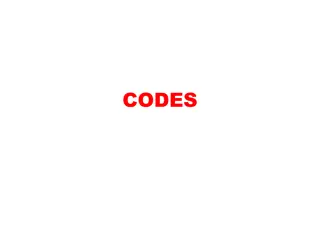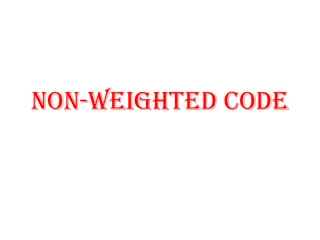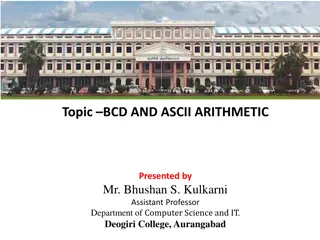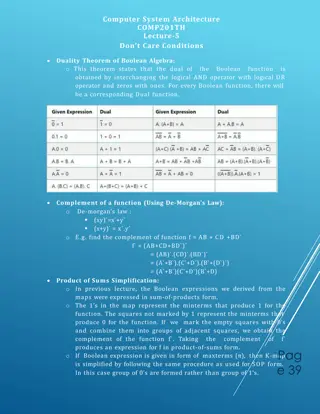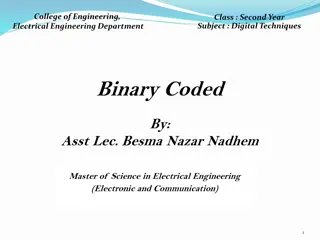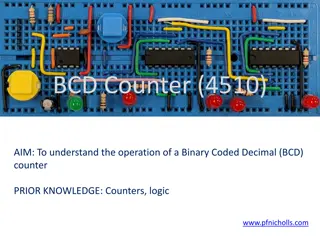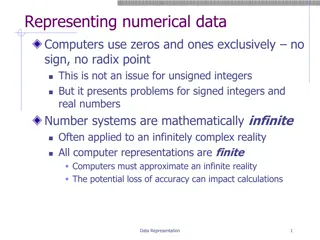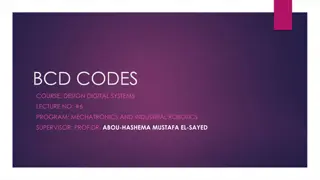BCD CODES
Topic of BCD codes in the design of digital systems for the Mechatronics and Industrial Robotics program. Professor Dr. Abou-Hashema Mustafa El-Sayed is the supervisor for this course.
6 views • 11 slides
Binary Codes and Their Applications
Binary coding is crucial for digital systems as they understand only 0s and 1s. This process converts information into binary language for processing by digital circuits. Different types of binary codes like weighted codes and BCD codes are used for error correction, digital communication, and compu
8 views • 20 slides
Encoder and Decoder in Combinational Logic Circuits
In the world of digital systems, encoders and decoders play a crucial role in converting incoming information into appropriate binary forms for processing and output. Encoders transform data into binary codes suitable for display, while decoders ensure that binary data is correctly interpreted and u
8 views • 18 slides
Non-Weighted Codes and Excess-3 Code in Binary Systems
Explore non-weighted binary codes like Excess-3 code, learn how to convert decimal numbers to XS-3 code, advantages and disadvantages of BCD codes, and steps to convert Excess-3 code to binary. Discover the intricacies of binary coding systems with practical examples.
8 views • 55 slides
BCD and ASCII Arithmetic in 8086 Assembly Language
BCD (Binary-Coded Decimal) and ASCII (American Standard Code for Information Interchange) are key concepts in 8086 assembly language for numerical and character manipulations. BCD Arithmetic involves addition and subtraction techniques using instructions like DAA and DAS. The adjustment instructions
6 views • 21 slides
Boolean Algebra: Duality Theorem, De-Morgan's Law, and Don't Care Conditions
Boolean algebra concepts such as the Duality Theorem, De-Morgan's Law, and Don't Care Conditions are essential for digital circuit design. The Duality Theorem states the relationship between a Boolean function and its dual function by interchanging AND with OR operators. De-Morgan's Law helps find t
4 views • 10 slides
Binary Codes and Self-Complementing Codes
The concept of binary codes, including Binary Coded Decimal (BCD) codes, and self-complementing codes is explored in this informative content. Learn about how decimal numbers are represented in binary form, the structure of BCD codes, and the properties of self-complementing codes like 2421 and Exce
6 views • 34 slides
Binary Coded Decimal (BCD) and Excess-3 Code
Binary Coded Decimal (BCD) is a binary code used to represent decimal numbers, with the popular 8421 BCD code and its conversion process explained. Additionally, Excess-3 Code, another BCD code, is detailed with an example of finding its code for a given decimal number. Different BCD codes like 4221
13 views • 11 slides
Binary Coded Decimal Counter Operation
In a BCD counter like the 4510, learn how it counts in decimal from 0 to 9 before resetting, its up-down feature, loading values, carry in/out functions, and clock control. Explore its binary-coded decimal output and cascading capability for extended counting. Understand the working of Q outputs, re
3 views • 14 slides
Arithmetic Operations in 8086 Assembly Language
Learn how to write programs for multiplication and division using different data sizes in 8086 assembly language. Explore arithmetic instructions for binary, BCD, and ASCII arithmetic, and understand the theory behind multiplication and division operations in microprocessors. Get insights into suppo
0 views • 20 slides
Computer Data Representation Challenges and Solutions
Computer systems use binary data representation, which poses challenges for representing signed integers and real numbers due to the exclusive use of zeros and ones. Various methods such as Binary-coded Decimal (BCD), signed-magnitude representation, and 9s complement are employed to address these c
3 views • 32 slides
Numerical Data Representation in Computers
Computers use zeros and ones exclusively for representing numerical data, which can pose challenges for signed integers and real numbers due to the finite nature of computer representations. Binary-coded decimal (BCD) and signed-magnitude representations are utilized to overcome these limitations. T
5 views • 10 slides
Data Representation in Computers: Numerical Challenges
Computers rely on binary representation for numerical data, posing challenges for signed integers and real numbers due to the exclusive use of zeros and ones. This finite representation of infinite number systems can lead to accuracy loss in calculations. Different methods like Binary-coded Decimal
1 views • 9 slides
Binary Coded Decimal Counter 4510
Learn about the operation of a BCD counter using the 4510 chip, including basic operations, up-down counting, loading values, and cascading counters for decimal counting applications.
3 views • 14 slides
Combinational Circuit Design COE 202 Digital Logic Design Procedure
This content delves into the design process of combinational logic circuits, outlining the steps from specification to verification. It covers topics such as logic optimization, technology mapping, and design verification using examples like BCD to Excess-3 Code Converter. The insights are valuable
5 views • 18 slides
Binary Codes in Digital Electronics
Explore the world of binary codes in digital electronics, including BCD, Excess-3, Gray codes, and ASCII codes. Learn about the advantages of binary coding and the classification of binary codes into weighted, non-weighted, BCD, alphanumeric, error detecting, and error correcting codes.
1 views • 14 slides
BCD Codes: Design Digital Systems & Mechatronics in Industrial Robotics
Explore 4-bit, 6-bit, and 8-bit BCD codes for designing digital systems in a course on Mechatronics and Industrial Robotics under the supervision of Prof. Dr. Abou-Hashema Mustafa El-Sayed.
6 views • 11 slides
Exploring Data Types in Computers: Binary, BCD, and Floating Point Formats
Delve into the world of data types in computers, from binary representations of integers to Binary Coded Decimal (BCD) encoding and double precision floating point numbers. Understand how different data types are used and represented in computer systems.
0 views • 20 slides

